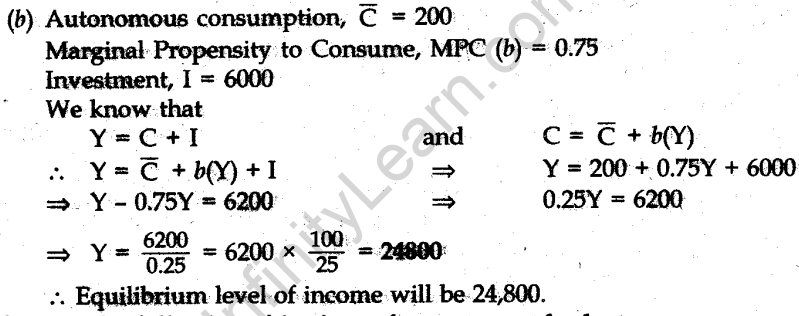Table of Contents
CBSE Sample Papers for Class 12 Economics Compartment Outside Delhi -2014
Time allowed : 3 hours Maximum marks 100
GENERAL INSTRUCTIONS
- All questions in both the sections are compulsory.
- Marks for questions are indicated against each.
- Questions No. 1-5 and 17-21 are very short-answer questions carrying 1 nick each. They are required to be answered in one sentence each.
- Questions No. 6-10 and 22-26 are? short-answer questions carrying 3 marks each. Answers to them should normally not exceed 60 words each.
- Questions No. 11-13 and 27-29 are also short-answer questions carrying 4 marks each. Answers to them should normally not exceed 70 words each.
- Questions No. 14-16 and 30-32 are long-answers questions carrying 6 marks each. Answers to them should normally not exceed 100 words each.
- Answers should be brief and to the point and the above word limit should be adhered to as far as possible.
SET I
SECTION A
Question.1 Name the economic value achievable when attempts are made to increase resources in.
the country.
Answer. Increase in resources in the country would lead to increase in output and ultimately increase in employment opportunities leading to increase in income.
Question.2 Define demand.
Answer. Demand is the quantity of a commodity that a consumer is willing and able to buy, at each possible price during a given period of time.
Question.3 Give two examples of fixed costs.
Answer. Salary of permanent staff and Insurance premium are two examples of fixed costs.
Question.4 Define market supply.
Answer. Market supply refers to the quantity of a commodity that all the firms are willing and able to offer for sale at given price during a given period of time.
Question. 5 When is supply of a good said to be perfectly price inelastic?
Answer. When the supply of a good does not change with the change in its price, then the supply of such a commodity is said to^be perfectly price inelastic.
Question.6 Why does the problem of ‘how to produce’ arise? Explain.
Answer. This problem refers to selection of technique to be used for production of goods and services. This problem arises because resources are limited and have alternate uses. This is why we are forced to make a choice between alternate uses of resources and the commodities to be produced. Generally, techniques are classified as labour intensive and capital intensive. The selection of technique is made with a view to achieve the objective of raising the standard of living of people and to provide employment to everyone using least possible scarce resources.
Question.7 A and B are complementary goods. Explain the effects of change in price of A on demand for B.
Answer. Complementary goods are those goods which are used together to satisfy a particular want like petrol and car. An increase in the price of a complementary good leads to a decrease in the demand for the given commodity and vice-versa. For example, if price of complementary good A increases then demand for the given commodity B will also fall alongwith demand for A, as it will be relatively costlier to use both the goods together.
Similarly, if price of Commodity A decreases then demand for commodity B will increase
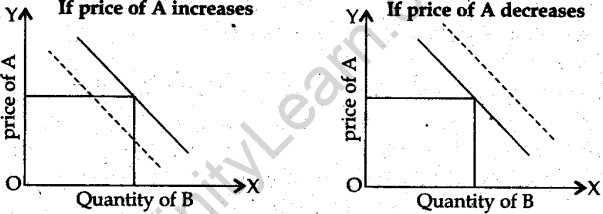
Question.8 Calculate marginal cost at each level of output.

Solution.

Question.9 When price of a commodity rises from Rs 5 to Rs 6 per unit, total revenue increases from Rs 1,000 to Rs 1,200. Calculate its price elasticity of supply.
Solution.

Question.10 Explain any two causes of “decrease” in supply of a commodity.
Answer.
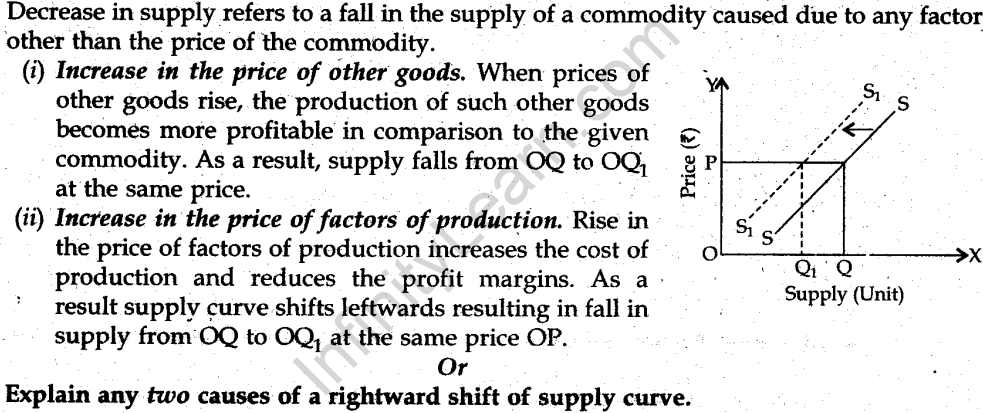
Answer.
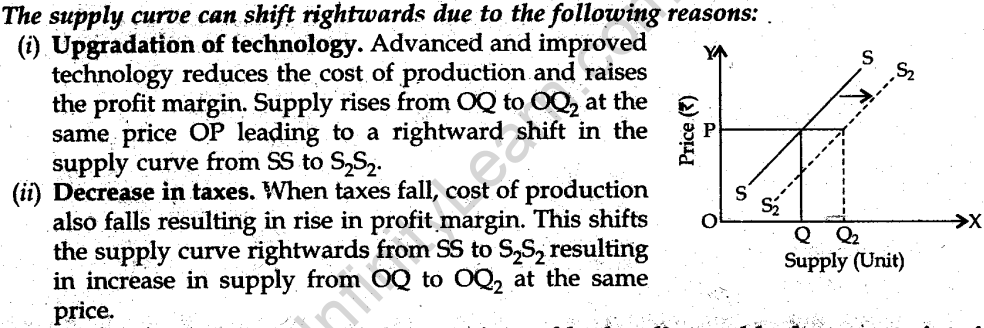
Question.11 Explain the between the equations of budget line and budget constraint
Solution.
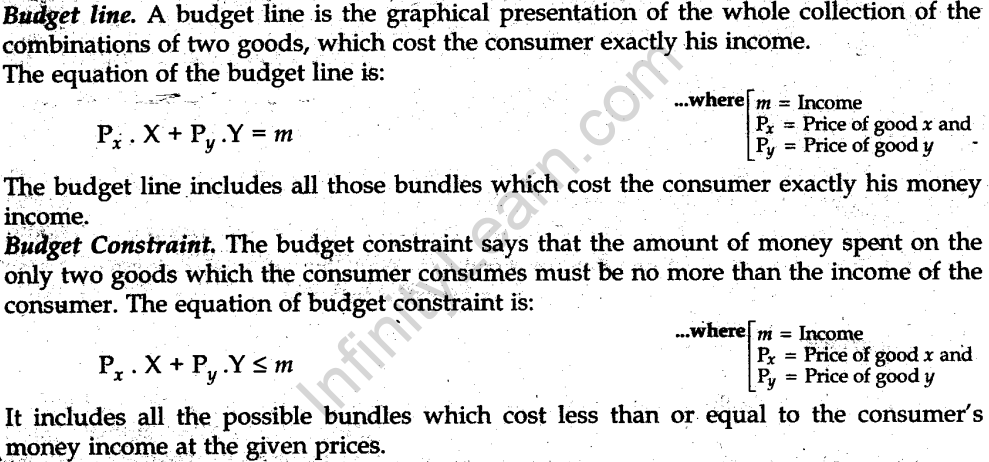
Question.12 The price elasticity df demand of a good is (-) 0.5. At a price of ?20 per unit its demand is 300 units. At what price will its demand increase by 10 per cent.
Solution.

Question.13 Define monopoly. State the main features of monopoly.
Answer. Monopoly refers to a market situation where there is a single seller selling a product which has no close substitutes.
The main features of monopoly are:
- A single seller. There is only one producer of a product. It may be due to some
natural conditions prevailing in the market Or may be due to some legal restrictions in the form of patent, copyright etc. - No close substitutes. A monopoly product has no close substitutes and therefore practically does not face any competition.
- Barriers to the entry to new firms. The barriers may be due to legal restrictions created by firms in the form of cartels.
Question.14 From the following data find out the level of output at which the producer is in equilibrium. Give reasons “for your answer. (Use marginal cost, marginal revenue approach)

Solution.

According to MR-MC approach, the producer attains equilibrium where the following conditions are fulfilled:
(i) MR = MC
(ii) MC must be rising after the equilibrium Level of output.
thus, we can say that die producer is in equilibrium at output equal to 4 unite because at this stage both the equilibrium conditions are being satisfied.
At output level of 3 units, MR > MC implying that higher profits can be achieved by increasing the level of output. Also, if the firm produces slightly higher level of output than 4 units, then the firm’s MC > MR making profits negative. Thus producer’s equilibrium will be at 4 utiits of output.
Question.15 Explain the characteristics of indifference curves.
Answer. See Q. 15,2011 (I Delhi)
Or
Explain the conditions of consumer’s equilibrium using utility analysis.
Answer. See Q. 7(0), 2013 (I Delhi).
Question.16 Explain the changes that will take place in the market when market price of a good is less than its equilibrium price. Use diagram.
Answer.

Note: The following Question is for the Blind Candidates only in lieu of Q. No. 16.
Explain the changes that will take place in the market when market price of a good is less than its equilibrium price. Use a schedule.
Answer. Read Answer 16 and add:
Suppose the equilibrium price is ?5 at which demand equals supply. Further suppose that market price falls to ?4. This will lead to excess demand and competition between the buyers. As a result demand will start falling arid supply will start increasing. The changes will continue till prices rises to ?5 per unit at which demand equals supply.
SECTION B
Question.17 Give the meaning of depreciation.
Answer. Depreciation .refers to a fall in the value of fixed assets due to normal wear and tear, passage of time or expected obsolescence.
Question.18 Define domestic product.
Answer. Domestic product means the value of final goods and services produced within the economic territory of a country within a period of one year.
Question.19 What is meant by bank rate?
Answer. Bank rate is the rate of interest at which the central bank of the country lends money to the commercial banks of that country.
Question.20 What is a tax?
Answer. Tax is a legal compulsory payment imposed by the government on income and business profits or on cost of some goods, services and transactions.
Question.21 Give two examples of revenue expenditure.
Answer. Examples of revenue expenditure: Expenditure on Salaries; Pensions etc.
Question.22 Distinguish between real and nominal gross domestic product.
Answer. Nominal GDP or GDP at Current Prices. When GDP of a given year is estimated on the basis of prices of the same (current) year, it is called nominal GDP.
Islominal GDP can increase even without any increase in physical output as it is affected by changes in prices also.
Real GDP or GDP at Constant Prices. When GDP of a given year is estimated on the basis of prices of a base year, it is called real GDP. Real GDP helps in determining the effect of increased production of goods and services as it is affected by change in physical output only.
Question.23 Explain the ‘unit of account’ function of money.
Answer. See Q. 23, 2014 (I Outside Delhi).
Or
Explain the role of central bank as the’Bankers’Bank’
Answer. See Q. 27(Or), 2014 (I Outside Delhi).
Question.24 The value of marginal propensity to consume is double the value of marginal propensity to save. Find the value of multiplier.
Answer.
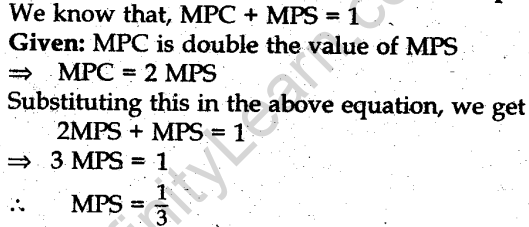

Question.25 In an economy planned spending is greater than planned output. Explain all the changes that will take place in the economy.
Answer. When planned spending (Aggregate Demand AD) is more than the planned output (Aggregate Supply AS), it implies that the consumers and the firms together would be buying more goods than the firms are willing to produce. As a result, the planned inventory would fall below the desired level. To bring the inventory back to the desired, level, the firms would resort to increase in employment and output until the economy is back at the equilibrium level of income and output, where AD becomes equal to AS and there is no further tendency to change.
Question.26 Distinguish between Balance of trade and Balance on current account of the Balance ofPayments account.
Answer. See Q. 24, 2009 (I Outside Delhi).
Question.27 From the following data, calculate “Net value added at factor cost”.

Answer.

Or
Is gross domestic product a true index of economic welfare of the people? Give two reasons in support of your answer.
Answer. The term welfare refers to the sense of well-being. Welfare is affected by a wide range of factors—both economic and non-economic.
GDP at its best, indicates economic welfare. However, it is not a satisfactory measure of economic welfare due to the following limitations:
- Externalities. These are the benefits or harms of an activity caused by a firm or an individual for which they are not paid or penalised. As such since these external effects do not form part of market transactions, GDP does not consider such negative externalities.
- Non-monetary exchanges. These activities though influence economic welfare are
not considered while measuring GDP, for example, services of housewives, own account production etc. They are not included in the GDP due to non-availability of data and problem of valuation.
Question.28 How does the central bank control credit creation in the economy through “Bank Rate”? Explain.
Answer. Bank rate is the rate at which the central bank lends money to commercial banks. An increase in bank rate increases the cost of borrowing from the central bank. It forces the commercial banks to increase their lending rates which discourages the borrowers from taking loans. It reduces the ability of commercial banks to create credit.
A decrease in the bank rate, on the contrary will encourage the borrowers to take more loans which will increase the ability of commercial banks to create credit.
Question.29 Government takes measures to restrict autonomous imports of gold. Explain the economic values desired to be achieved from this.
Answer.

Question.30 Calculate national income:

Answer.
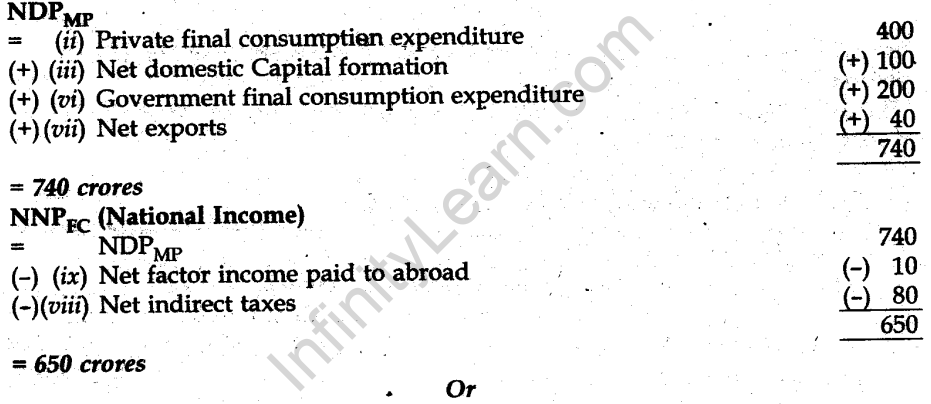
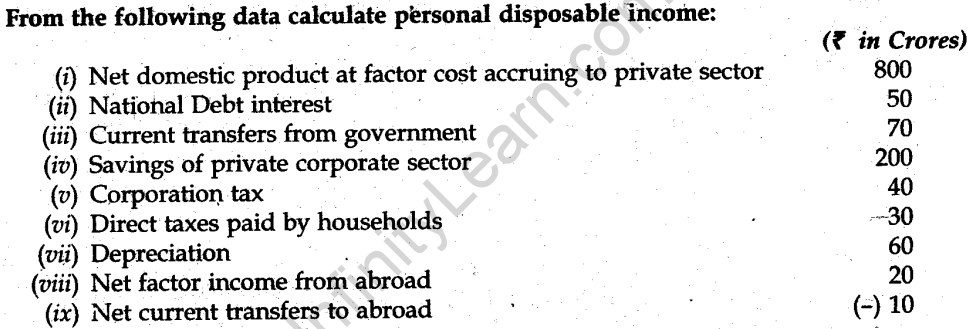
Solution.
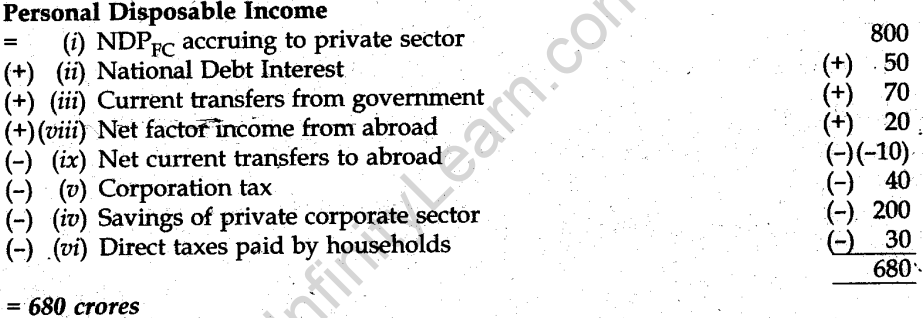
Question.31 (a) Explain the distinction between ex-ante measures and ex-post measures.
(b) From the following data about an economy, calculate its equilibrium level of income:
(i) Autonomous Consumption = 200
(ii) Marginal propensity to consume = 0.9
(iii) Investment = 1000
Answer. (a) Ex-ante measures mean planned and ex-post mean actual or realised. Both these terms are generally used in the context of savings and investment.
Ex ante savings are the desired savings and ex-ante investment refers to the desired or planned investment during the period of one year.
Whereas ex-post savings and investment are the actual savings and investment in the economy during the period of one year.
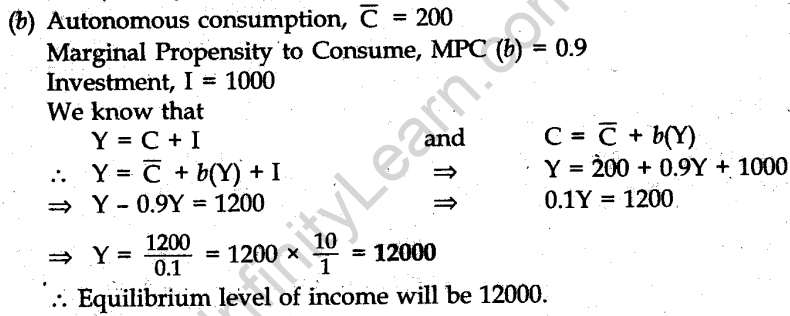
Question.32 Distinguish between:
(a) Direct tax and Indirect tax
(b) Primary deficit and Revenue deficit
Answer.
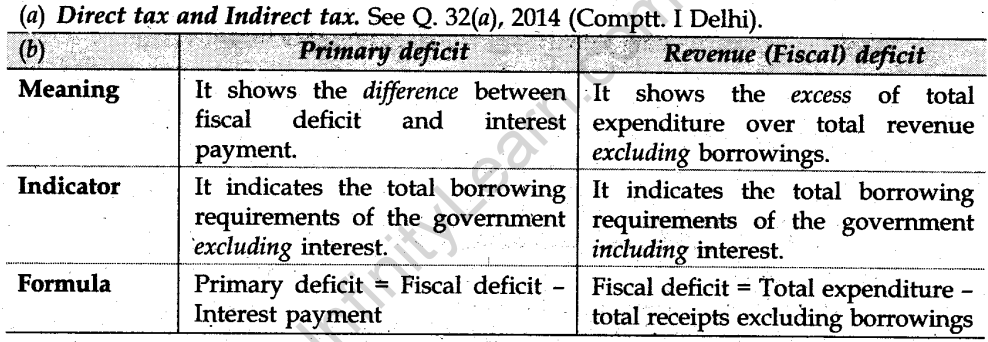
SET II
Note: Expect from the following questions, all the remaaining questions have been asked in set-I
SECTION A
Question.8 Calculate marginal cost at each level of output:

Answer.

Question.9 Ftom the following data calculate price elasticity of supply:

Answer.

Question.12 The price elasticity of demand of a good is (-) 0.5. At a price of Rs 40 per unit its demand is 300 units. At what price will its demand increase by 20 per cent?
Solution.


Question.16 Explain the changes that will take place in the market when market price of a good is greater than its equilibrium price. Use diagram.
Answer.
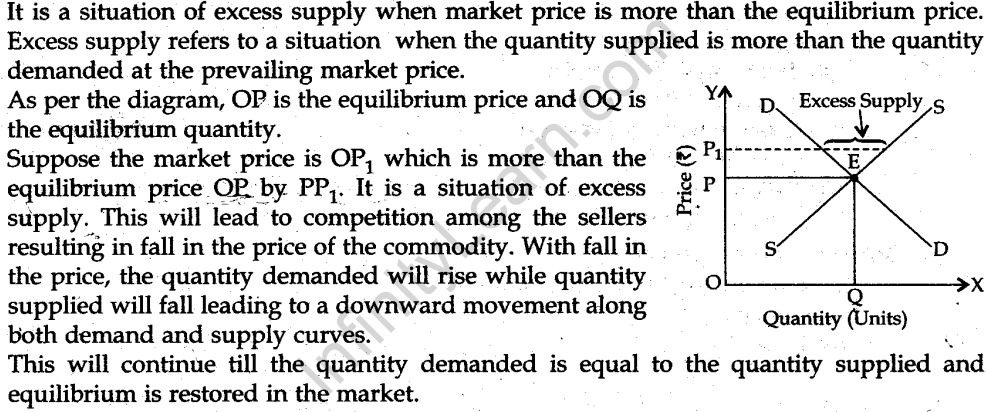
Note: The following Question is for the Blind Candidates only in lieu of Q. No. 16.
Explain the changes that will take place in the market when market price of a good is greater than its equilibrium price. Use a schedule.
Answer. Please read the answer above and add:

Market DD (Units) Market SS (Units)
In the above table, equilibrium price is Rs 3 per unit and equilibrium quantity is 30 units. But suppose the market price is Rs 4 at which market supply is greater than the market demand. Competition among the sellers will lead to a decline in the price which will increase the demand and decrease supply to 30 units which is the equilibrium quantity.
SECTION B
Question.19 What is meant by cash reserve ratio?
Answer. Cash Reserve Ratio is the fraction of deposits the banks are required to keep with the central bank.
Question.20 Define an indirect tax.
Answer. When the ‘liability to pay’ and ‘incidence’ of a tax lie on different persons, it is called an indirect tax.
Question.31
(a) Define aggregate demand. What are its components?
(b) From the following data about an economy, calculate its equilibrium level of Income:
(i) Marginal propensity to consume = 0.75
(ii) Autonomous Consumption = 200
(iii) Investment = 6000
Answer. (a) Aggregate demand reiers to the total value of final goods and. services that all sectors of the economy taken together are planning to buy at a given level of income during a period oftime. Its various components are as follows:
- Private Consumption Expenditure (G). The planned expenditure on final consumer goods and services by the households at a level of income during a given period of time.
- Investment Ependiture (I). Planned’expenditure on new capital goods by the producers during a period of time.
- Government Expenditure (G). Planned consumption expenditure of general government on providing free services to the people.
- Net Exports. Planned netexpenditure by the foreigners on the goods and services produced in the country during a period.

Question.32 Explain the following objectives of government budget:
(a) Allocation of resources
(b) Reduction in inequalities of income
Answer.
(a) Objective of alloeatian ef resources. Through the budgetary policy, government aims to reallocate resources in accordance with the economic (profit maximisation) and social (public welfare) priorities of the country. The government can influence the allocation of resources by encouraging the private sector through tax concessions, subsidies etc. to undertake certainproduction in publicinterest-Ifprivateseetor does not take interest, government can directly undertake production.
(b) Objective of reduction in inequalities of income. Economic inequality is an inherent part of every economic system. The Government aims to reduce such inequalities through its budgetary policy by imposing taxes on the rich and spending more on the welfare of the poor. Increased taxes will reduce the income of the rich and government spending will raise the standard of living oft the poop thus reducing inequalities in the distribution of income.
SET III
Note: Except for the following questions, all the remaining questions have hem asked in Set-I. and Set-II
Question. 8 Calculate average variable cost at each level of output:

Solution.

Question. 9 Calculate price elasticity of supply from the following data:

Solution.

Question.12 The price elasticity of demand of a good is (-)l. At a price of ?10 per unit its demand is 500 units. At what price will its demand increase by 20 per cent?
Answer.
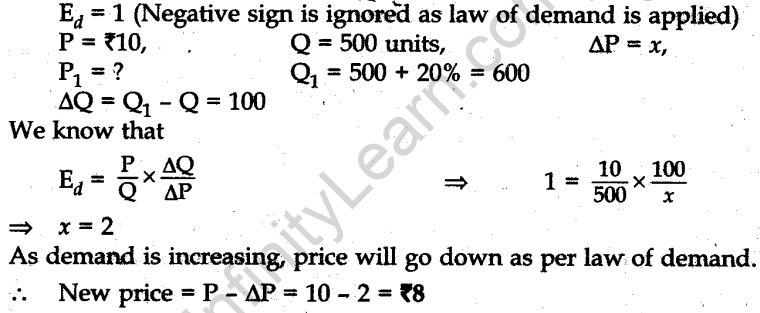
SECTION B
Question.19 What is statutory liquidity ratio?
Answer. Statutory liquidity ratio refers to the minimum percentage of net demand and time deposits which the commercial banks are required to maintain with themselves.
Question.20 Define a government budget.
Answer. A Government budget is an annual statement showing itemwise estimats of reciepts and expenditures during a fiscal year.
Question.25 Distinguish between stocks and flows. Give an example of each
Answer.

Question.26 Explain the meaning of average propensity to consume. What is its relation with average propensity to save?
Answer. Average propensity to consume refers to the ratio of consumption expenditure to the corresponding level of income.

Question.31
(a) Distinguish between autonomous consumption and induced consumption.
(b) From the following data about an economy, calculate its equilibrium level of income:
(i) Autonomous Consumption = 400
(ii) Marginal propensity to consume = 0.5
(iii) Investment = 4000
Answer.
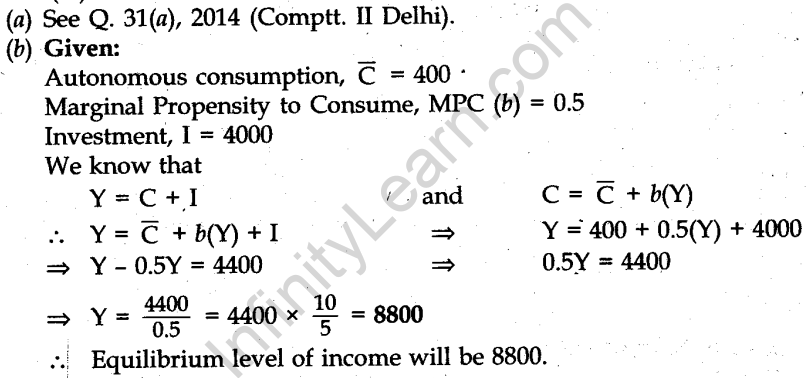
EconomicsBusiness StudiesAccountancyMathsEnglish




